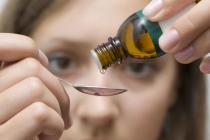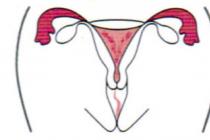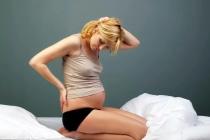The menstrual cycle is the changes that occur in a woman's genitals at approximately equal intervals of time.
What is the length of the menstrual cycle?
The normal length of the menstrual cycle is 21 to 35 days. The countdown of the menstrual cycle starts from the first day of bleeding.
Phases of the menstrual cycle and the hormones that regulate them
The menstrual cycle is divided into two phases, between which ovulation occurs.
The first phase is called follicular. It is in this phase that the follicle develops, from which the egg will be released, which can then turn into a developing fetus and, finally, a child. It starts on the very first day of menstruation (menstrual bleeding) and ends when ovulation occurs. It takes about half of the entire cycle. Special cells in this phase produce the sex hormones estrogen. During the entire follicular phase of the menstrual cycle, a woman's basal body temperature, as a rule, stays below 37 degrees. The temperature must be known to clarify the moment of ovulation - at the time of ovulation, the basal temperature will drop sharply.
The next phase of the menstrual cycle - luteal, or the corpus luteum phase. The corpus luteum is formed in the ovary at the site of the released egg. This phase occurs immediately after ovulation and lasts as long as the yellow case exists, that is, on average, about 12-14 days. The main task at this stage is to maintain the balance of the hormones estrogen and progesterone, which the corpus luteum secretes to prepare the body for a possible pregnancy. In this phase, the basal body temperature can stay at 37 degrees, and then, before the onset of menstruation (menstrual bleeding), drop sharply.
Ovulation- the release of a mature (ready for fertilization) egg from the follicle into the abdominal cavity, followed by advancement through the fallopian tubes to the uterus itself. In the body of a woman by the time of puberty, approximately 300-400 thousand eggs are stored. All of them are in the ovaries from birth and are laid in the womb. The first ovulation occurs a little later than the onset of puberty, the last - after the extinction of the menstrual function, with menopause. During pregnancy, ovulation also does not occur, but after the birth of the child, it is restored.
Establishing the moment of ovulation is of interest mainly to those women who want to become pregnant, since the possibility of pregnancy exists only on certain days: 3-4 days before ovulation, during ovulation and 1-2 days after it.
Fig.: Phases of the menstrual cycle
Periods (phases) of the menstrual cycle
In each menstrual cycle, a woman's body prepares for pregnancy. The menstrual cycle can be divided into several periods (phases).
Most often, the duration of the menstrual cycle is 28 calendar days. However, for each woman it is strictly individual; it is normal if it fits in the interval from 21 to 35 days. The main factor is its constancy throughout the entire reproductive period, the permissible deviations are no more than 3 days. An important indicator is also the amount of discharge and the well-being of a woman during this period. Any changes in the normal rhythm, signs of malaise are a reason to see a doctor, as they may well be the first signs of the disease.
menstrual period of the cycle
The functioning of the female reproductive system is subject to four main periods. The first of them is menstrual, it is the most painful, it is at this time that spotting is observed. Its normal duration is 3 to 6 days. At this stage, there is a rejection and expulsion of the inner lining of the uterus - the endometrium, along with an unfertilized egg. Thus, the first day of bleeding is the beginning of the menstrual cycle.
Follicular period of the cycle
Then follows the follicular period, characterized by the cessation of secretions. At this time, an increased synthesis of hormones from the pituitary and hypothalamus begins, which affect the ovaries. The main one is follicle-stimulating hormone (FSH), which causes intensive growth and development of several follicles. The ovaries, in turn, produce the sex hormone estrogen; its significance is to stimulate the renewal of the endometrium and prepare the uterus to accept the egg. This stage lasts about two weeks and ends due to the release of hormones into the blood that suppress the activity of FSH.
Ovulation
The ovulation phase begins, that is, the release of a mature egg from the follicle. As a rule, this is the largest of them. This is facilitated by a sharp increase in the level of luteinizing hormone (LH). The egg enters the lumen of the fallopian tube and begins its movement towards the uterus, while waiting for fertilization. The duration of her life does not exceed two days, therefore, to increase the likelihood of conception, it is necessary that the sperm is already in the fallopian tube. In the uterus at this time, the process of preparing the epithelial layer continues.
luteinizing period of the cycle
The final period of the menstrual cycle is luteinizing. Its duration, as a rule, does not exceed 16 days. At this time, in place of the follicle that the egg left, a special temporary gland is formed - the corpus luteum. It produces progesterone, designed to increase the sensitivity of the endometrium, in order to facilitate the introduction of a fertilized egg into the uterine wall. If implantation does not occur, the corpus luteum regresses and progesterone levels plummet. This causes destruction and subsequent rejection of the epithelial layer, the cycle closes.
Phases of the menstrual cycle
 |
 |
 |
|
First phase (follicular, or egg development) Day 1-5. Menstruation. Typically, menstruation lasts from 2 to 7 days, with an average of 5 days. During this phase, the lining of the uterus (endometrium) is shed and menstruation begins. Uterine contractions at this point may be accompanied by pain in the lower abdomen. Some women have short periods (eg 2 days), while others can last up to 7 days. Bleeding may be profuse and spotting. In the first half of the menstrual cycle, a follicle grows in the ovary, where an egg develops and matures, which then leaves the ovary (ovulation). This phase lasts about 7-21 days, depending on many factors. |
Ovulation Day 14. Release of the egg. Usually ovulation occurs from the 7th to the 21st day of the cycle, more often in the middle of the menstrual cycle (approximately on the 14th day in a 28-day cycle). After leaving the ovary, the mature egg moves to the uterus through the fallopian tubes. |
Second phase (formation of the corpus luteum) Day 15-28. Thickening of the inner lining of the uterus. After ovulation, the ruptured follicle transforms into the corpus luteum, which produces the hormone progesterone. |
Each representative of the fair sex has to deal monthly with the phases of her menstrual cycle, with their own characteristics and characteristic symptoms. These phases are significant stages that are responsible for the reproductive function of the female body. The duration and nature of the menstrual phases are more individual, but the basics and sequence of their flow remain unchanged and have their respective names. This whole significant process is cyclical, and begins with the advent of menstrual bleeding, which is considered to be the first of the three phases of the menstrual cycle.
Any girl or woman in the age range from puberty to menopause must understand the work of her body and understand the purpose of all three phases of the menstrual cycle. With the help of this knowledge, you can easily calculate the favorable period for conceiving a child or, on the contrary, protect yourself from unwanted pregnancy and some health problems.
The main phases of the cycle
Every month, with a regular cycle in the body of a woman, three successive phases of the menstrual cycle occur. They are characterized by a logical sequence and serve one big goal - creating favorable conditions for the fertilization of the egg and procreation. The menstrual cycle is divided into three main phases:
- Follicular (first phase);
- Ovulation (second phase);
- Luteal (third phase).
These stages perform the functions according to their name. These phases are based on hormonal regulation, which promotes the process and controls its outcome. The beginning of the menstrual cycle is the beginning of the very first phase - the follicular, it is she who starts such an important process as the formation and.
The first is the follicular phase
The initial phase of the menstrual cycle is characterized by intensive growth of follicles and the formation of an egg in them. The first day of menstruation kicks off a new follicular phase of the cycle and begins intensive production of follicle-stimulating hormone and estrogen. During this period, there is a growth of follicles, which a little later will become a receptacle and a place for the maturation of the egg.

Estrogen provides support to the follicles and this lasts about 7 days, until one of the follicular vesicles reaches the necessary parameters for the maturation of an egg in it. Further, the focus of growth is only on the egg, and the "extra" follicles stop functioning. A high concentration of estrogen gives a signal to start the production of luteinizing hormone, which, in turn, prepares for future ovulation. The duration of the first phase is individual for each woman, but it should not exceed 20 days.
Read also 🗓 Beige discharge in women
The second phase is ovulation
The second phase of the menstrual cycle is quite short, but at the same time very significant. Ovulation is the achievement for which the menstrual cycle actually exists. It is intended for the possibility of fertilization and the realization of the main purpose of a woman - procreation. The ability and possibility of fertilization is possible in just 48 hours, and sometimes less. During this short period of 2 days, the woman's reproductive system is faced with a responsible task, and if fertilization does not occur, the egg dies.

An increased concentration of luteinizing hormone contributes to increased maturation and subsequent release of the egg from the follicle. Under its action, important processes occur that ensure the preparation of the walls of the endometrium. When the egg reaches full maturity and is ready for fertilization, the follicular vesicle ruptures and a full-fledged egg enters the fallopian tube to merge with the sperm. In the cavity of the ruptured follicle, an intensive growth of the corpus luteum begins, which, in turn, leads to an intensive production of progesterone and provides favorable conditions for successful fertilization and implantation of a fertilized ovum into the uterine wall. The next cycle can have 2 outcomes, depending on whether fertilization has occurred or not.
Third phase - luteal
The development of the third phase of the menstrual cycle can take place in two scenarios: with a fertilized egg or if fertilization has not occurred. This time, special attention is paid to the formed corpus luteum. It, in case of successful conception, leads to the active production of luteal hormone, which supports and nourishes the fertilized egg until the placenta is formed. Due to the importance of the purpose of this hormone, the third phase has its characteristic name - luteal. Together with the luteal hormone, during this period, the active production of progesterone, which is also actively involved in supporting the fetal egg, continues. Ultimately, the harmonious and mutually beneficial production of female hormones provides a complete preparation for fertilization, fusion, and subsequent nutrition and protection of the already fertilized fetal egg.

If fertilization still does not occur, the corpus luteum stops its development and atrophies. The prepared loosened uterine mucosa and the dead egg are rejected and come out in the form of menstrual bleeding, which, in turn, already means the beginning of a new, first phase, and the entire described process is repeated anew.
Read also 🗓 Purulent discharge
Cycle phases by day
The phases of the menstrual cycle by day are conditionally divided into 3 intervals. The first and third phases are considered the longest. At the same time, it is interesting that the follicular and ovulation phases have an individual and unfixed duration, and the luteal phase always corresponds in duration - 2 weeks or 14 days. As many people know, the entire menstrual cycle can last from 20 to 35 days, and this will be considered the norm. Menstrual bleeding is also individual in nature, but it is necessary for every lady.

To understand what and when happens during these +/- 28 days, it is necessary to consider the duration of each specific phase.
- The follicular phase is the period from the beginning of menstruation to the full readiness for the release of the egg from the follicle (ovulation). Depending on the characteristics of the body, it can last from 7 to 20 days. At the beginning of this phase, a woman experiences malaise and discomfort in the lumbar region and lower abdomen. Later, strength is restored and unpleasant symptoms recede.
- - the time when the egg is ready for fertilization. This phase is the shortest and most important. The ability of the egg to merge with the sperm and fertilize lasts from 20 to 48 hours, which is also purely individual and depends on many factors. Some women feel ovulation and even observe characteristic discharge on their underwear.
- . Regardless of whether fertilization has occurred or not, this phase continues for the last 14 days. If pregnancy has not occurred, then its end and, therefore, the beginning of a new cycle will be monthly bleeding. During this period, many ladies suffer from premenstrual syndrome () and experience not the most pleasant physical and psychological symptoms and sensations in their body. If, nevertheless, the menstrual cycle has fulfilled its intended purpose, and fertilization has taken place, then pregnancy occurs and further actions of female hormones will focus on the growth, nutrition and development of the fetus.
What can affect the shift of the cycle
The considered phases of menstruation are a very clear and fragile mechanism that can be broken due to many factors. The main promoters of these phases are hormones that mutually benefit each other to achieve a common goal - the conception and birth of a child. Violation of the production of any of the hormones will lead to a break in the sequential chain and will affect the final outcome and the duration of the cycle.
The menstrual cycle consists of several phases. The phases of the cycle of menstruation by day are divided by gynecologists as follows:
- menstrual phase: 3 to 6 days;
- the second phase is follicular: about 14 days;
- ovulation phase: about 3 days;
- luteal phase: 14-16 days.
menstrual phase
The beginning of the menstrual cycle should be considered the first day of the onset of menstruation. This physiological process occurs due to the rejection of the endometrium of the uterus. Bloody discharge in each woman can have a different character: from heavy bleeding to smearing. When the endometrium of the uterus is shed, the body prepares for the formation of a new egg. Each menstrual cycle is the preparation of the female body for fertilization and pregnancy.
The first phase of the cycle is accompanied by pain in the lower abdomen, weakness, drowsiness and irritability. These days it is better to refrain from physical activity and, if the life schedule allows, to rest more and stay in a calm atmosphere.
 Painful sensations can be reduced by such drugs: Tamipul, Spazmalgon, No-shpa, Paracetamol. It should be noted that all medicines should be taken only after the recommendation of the doctor.
Painful sensations can be reduced by such drugs: Tamipul, Spazmalgon, No-shpa, Paracetamol. It should be noted that all medicines should be taken only after the recommendation of the doctor.
In healthy women, these symptoms appear in a mild form. Often the cause of painful menstruation can be:
- Heredity. If a mother or grandmother suffered from pain before menstruation, then there is a high probability of these manifestations in the next generations.
- Pathology of the uterus: bend, curvature or underdevelopment of the organ. In this case, the pain syndrome will accompany menstruation even in women who have given birth.
- The occurrence of tension in the pelvis due to contraction of the uterine muscles.
- Compression of nerve endings due to enlargement of the uterus.
- Increased sensitivity of the body to ongoing physiological processes.
- An increase in prostaglandin hormones, which act on the genitals and thus cause pain.
- Stagnation of blood in the pelvis and swelling of the tissues.
- Intrauterine device. It can cause intense contraction of the muscles of the uterus, resulting in pain.
 However, very often painful periods are associated with inflammatory processes in the pelvic organs. To make sure that these manifestations are absent, it is necessary to be examined by a doctor and, if necessary, undergo a course of treatment.
However, very often painful periods are associated with inflammatory processes in the pelvic organs. To make sure that these manifestations are absent, it is necessary to be examined by a doctor and, if necessary, undergo a course of treatment.
During menstruation, a healthy woman loses about 10 ml of blood. To avoid anemia, these days you should eat more fruits, vegetables containing iron, and also take a complex of vitamins. This applies primarily to teenage girls, whose body is not yet fully formed.
During this period, fresh air and a calm environment are useful for a woman. Family members should not forget that during the period of menstruation, complex hormonal changes occur in a woman’s body, which is why she perceives everything very sharply, she can be irritable and unbalanced. Therefore, the best medicine these days for a woman will be support and understanding from relatives.
Follicular phase and ovulation
The second phase of the monthly cycle lasts about 2 weeks after the end of bleeding. However, stress and lifestyle changes can interfere with the normal duration of this phase.
During this period, the ovaries produce a hormone that stimulates the development of follicles, FSH. In the dominant follicle, the ovum subsequently matures.
The follicular phase is characterized by the release of the hormone estrogen, which promotes the renewal of the uterine wall. This hormone affects the biological environment in the cervix, making it insensitive to sperm. Nature decreed that during this period the female body is preparing for fertilization, and premature ingestion of sperm is undesirable.
Estrogen is considered the main beauty hormone. Skin, hair and nails become strong and beautiful. During this period, any cosmetic procedures are appropriate.
On day 14, the body releases the luteinizing hormone LH, while the production of the hormone FSH decreases. The LH hormone has a beneficial effect on the mucus in the cervix, making it receptive to sperm. Under the influence of this hormone, the maturation of the egg ends and it is released from the follicle.
 This process is called ovulation, which lasts from 2 to 4 days. This is the most favorable time for conception. Many girls who want to get pregnant calculate these days according to the calendar.
This process is called ovulation, which lasts from 2 to 4 days. This is the most favorable time for conception. Many girls who want to get pregnant calculate these days according to the calendar.
The mature egg moves through the fallopian tubes, where it waits for a meeting with the sperm within 2 days. Spermatozoa are able to live for about 5 days, so if sexual intercourse occurred shortly before ovulation, then there will be a high probability of fertilization of the egg.
In this phase, the girls' appetite increases, which threatens with rapid weight gain. This is due to the accumulation of the necessary nutrients in the body in case of a possible pregnancy. At this time, it is better to increase the consumption of dairy products and plant foods.
The probability of conception is possible already from the 9th day of the cycle. There is even a certain theory of conception of the desired sex of the child. If parents dream of a girl, then sexual intercourse should be performed before ovulation, since the X chromosome, which determines the female sex, is more viable. And if the desired sex of the child is male, then it should be conceived on the days of ovulation - on the 12-14th day of the cycle.
In ancient Eastern teachings, it is said that before ovulation, a woman accumulates energy, and after ovulation, it is redistributed. Saving energy allows a woman to achieve harmony and peace of mind.
Women during the period of ovulation have a special smell that attracts men. She shines with beauty, health, and her sexuality these days is at the highest level.
Luteal phase of the menstrual cycle
 After the release of the egg, the empty follicle, or corpus luteum, begins to produce the hormone progesterone. It prepares the endometrium of the uterine cavity for the introduction of a fertilized egg. At this time, the production of the LH hormone ends and the cervical mucus dries up.
After the release of the egg, the empty follicle, or corpus luteum, begins to produce the hormone progesterone. It prepares the endometrium of the uterine cavity for the introduction of a fertilized egg. At this time, the production of the LH hormone ends and the cervical mucus dries up.
The luteal phase lasts 14 to 16 days. The female body is preparing for the introduction of the embryo. This process occurs within 6-12 days after fertilization. As soon as this has happened, the production of the hormone chorionic gonadotropin begins. It supports the function of the corpus luteum, which produces progesterone throughout pregnancy, which ensures the normal bearing of the child.
Modern pregnancy tests are sensitive specifically to human chorionic gonadotropin, which is called the pregnancy hormone.
If fertilization does not occur, then the corpus luteum and the egg die off, and the production of progesterone stops. The endometrium of the uterus also begins to collapse.
From the 20th day of the cycle, the concentration of luteinizing hormone decreases and the corpus luteum begins to reverse development in the ovary. It is believed that from this day the probability of getting pregnant becomes minimal.
At the end of the luteal phase, the top layer of the uterus begins to shed and subsequently exits with menstrual flow. This is the beginning of a new cycle.
 In the final phase of the menstrual cycle, the metabolism slows down. A week before the onset of menstruation, the work of the sebaceous glands of the skin intensifies. Girls get skin rashes. These days it is advisable to refrain from physical activity, as the connective tissues become more vulnerable.
In the final phase of the menstrual cycle, the metabolism slows down. A week before the onset of menstruation, the work of the sebaceous glands of the skin intensifies. Girls get skin rashes. These days it is advisable to refrain from physical activity, as the connective tissues become more vulnerable.
PMS - premenstrual syndrome - affects not only the appearance, but also the mental state of a woman. As a result of a drop in hormone levels, a woman becomes vulnerable and vulnerable, she needs the support and understanding of her relatives.
The mammary glands increase in size, there is daytime sleepiness, a feeling of anxiety or apathy. Gynecologists advise these days such "medicines" as sex and chocolate. However, in some women during PMS, libido decreases, so chocolate remains, which contributes to the production of the hormone of happiness.
The length of the menstrual cycle is different for every woman.
Therefore, the duration of the monthly phases for each woman may be different.
Cycles lasting from 21 to 32 days are considered normal.
Knowing your menstrual cycle will help you make informed decisions about your health and family planning. Doctors often ask when is the first day of your menstrual cycle. The tips below will help you identify this day.
Steps
Determining the first day of the cycle
-
Know that premenstrual syndrome is normal. For most women, symptoms appear 1-2 weeks before the onset of menstruation. As a rule, they pass with the onset of menstruation. All women react differently, so you should record your symptoms throughout your cycle.
Be aware of possible mood swings. On the eve of menstruation, many women become whiny, anxious, their mood changes dramatically or becomes depressive. A woman can also constantly feel tired and irritated. If your mood swings don't stop after your period starts, or if you think these mood swings are interfering with your normal life, you should see your doctor.
Pay attention to digestive symptoms. On the eve of menstruation, bloating, constipation, fluid retention in the body and diarrhea are possible. This can lead to weight gain at the beginning of the cycle. All these symptoms should also disappear in the first 4 days after the onset of menstruation. If it doesn't, see your doctor.
Pay attention to physical changes. Chest pain, joint and muscle pain, and headache are quite common. You can take a simple pain reliever (ibuprofen, aspirin, naproxen).
Know when to see a doctor. If you have five or more of the above symptoms and PMS is interfering with your normal life, you may have premenstrual dysphoric disorder. Your doctor may prescribe antidepressants, strong painkillers, or Jess birth control pills.
- In the treatment of premenstrual dysphoric disorder, it will be useful to work with a psychotherapist.
- You should also contact your doctor if your symptoms do not go away with your period, or if the frequency and severity of your symptoms change.
-
Know when to discuss your cycle with your doctor. If you have questions about your cycle, talk to your gynecologist. It is also important to see a doctor if your cycle has always been abnormal or has suddenly become so. It is extremely important to consult a gynecologist in the following cases:
Learn more about amenorrhea. Amenorrhea is the absence of menstruation. In women, menstruation should begin no later than the age of fifteen. If you or your daughter didn't start a period before age 15, see your doctor.
Find out if you have dysmenorrhea. Dysmenorrhea is a disease in which menstruation is very painful. Ibuprofen or similar medications may help ease the pain, but if it happens every time, you should talk to your doctor.
Watch for abnormal bleeding. If you have had a regular menstrual cycle before, you should know what is normal for you. Keep track of the regularity of your periods. If your periods become irregular, see your doctor.
Know what causes irregular periods. A variety of factors can lead to cycle disorders. If you keep your weight within the normal range and visit your gynecologist regularly, your cycle will not fluctuate.
Contact your doctor. Regular check-ups with a gynecologist should be undertaken to begin treating any abnormalities as soon as possible. Keeping track of your cycle and symptoms will help your doctor make the correct diagnosis and prescribe the appropriate treatment.
Understand what the menstrual cycle is. Menstruation begins in women when they reach puberty - at this time, a woman has the ability to conceive a child. There are several phases in the cycle (follicular, ovulation, luteal), and the first day of the cycle marks the beginning of the luteal phase, in which the uterus sheds its lining through the vagina. This is how menstruation begins.
Learn to identify the first day of your cycle. If you learn how to correctly count the days of the cycle, you will be able to make the right decisions regarding your health and family planning. To determine the first day of your cycle and how long it is, start numbering the days of your cycle, starting with the first day of your period.
Monitor your cycle for several months. If you do this from the first day of the cycle, it will be easier for you to track patterns and calculate the day the next period begins.
Determine the first day of the next cycle. If you know the length of the cycle, it will be easier for you to predict the date of the next menstruation.














